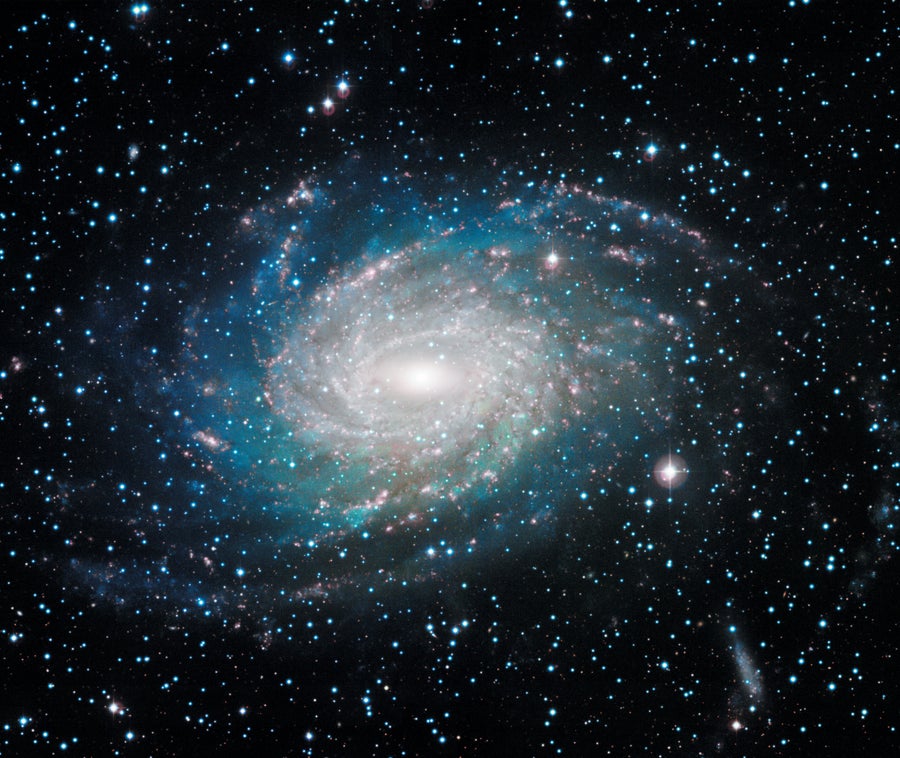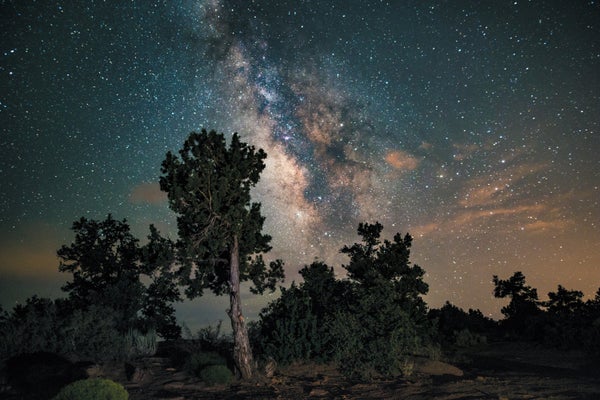The universe is filled with immense structures of mind-crushing proportions. They wield energies that vastly exceed our most fevered dreams.
Yet from Earth these configurations can barely be seen at all, even when you live inside one.
Case in point: Find yourself a dark spot where you can see lots of stars when the moon rises late—and look up. Stretching from the northern horizon to nearly directly overhead and then down again to the southern horizon, a broad whitish swath will be visible across the sky, faintly glowing like a dimly seen celestial river.
On supporting science journalism
If you're enjoying this article, consider supporting our award-winning journalism by subscribing. By purchasing a subscription you are helping to ensure the future of impactful stories about the discoveries and ideas shaping our world today.
That is the aptly named Milky Way. It spans 360 degrees of the sky in a continuous circle, enveloping Earth like a pale ring. It can be seen in the winter passing through familiar constellations such as Orion and Gemini. But for Northern Hemisphere observers, it's brightest and easiest to spot in the summer, when it appears as a wide trail of light splitting the sky. Near Deneb, the brightest star in the constellation Cygnus, the Milky Way appears to split in half, separated lengthwise by a dark lane poetically (if not ominously) called the Great Rift. This darkened cleft continues down toward the southern horizon even as the Milky Way itself broadens noticeably, and it bulges out into a lumpy blob near Sagittarius and Scorpius.
That's one of my favorite sights in the sky, actually. Sagittarius is generally depicted as the Archer, a centaur holding a bow. But to modern eyes the stars can uncannily resemble a teapot, with the traditional bow depicting the spout. In fact, the glow of the Milky Way looks like steam coming from the teapot, which is tipped over and ready to pour boiling water onto the tail of Scorpius!
That's a fanciful interpretation, sure. But once you see it for yourself, you'll appreciate why ancient people mythologized the heavenly scene. The most famous example, perhaps, is the Greek myth in which Hera pushes baby Heracles away from her bosom, and her breast milk spills from horizon to horizon. The Romans called this feature in the sky the via lactea (“milky road” or “milky way”), which is the origin of the modern name. The Greeks called it the galaktikós kyklos (“milky circle”), which is the source of the term “galaxy.” There's amusing redundancy in calling it the Milky Way galaxy, as many do. (Mea culpa: I'm guilty, too.)

Like many others such as the galaxy NGC 6744 (right), the Milky Way is a spiral galaxy. Credit: ESO
But what causes this glow? Astronomers have learned that its subtle impression on the eye belies its true nature.
Over the centuries many observers hypothesized that the Milky Way's soft luminescence was the collective glow from myriad stars that were too faint and close together in the sky to be individually distinguished. But the details of this structure stayed fuzzy (pardon my pun) until 1610, when Galileo confirmed the basic idea by turning his small telescope to the Milky Way and finding it was indeed composed of countless (at the time) stars. (Now we know it has at least 100 billion.)
The Milky Way's true shape—implied in its riverlike path across the sky—offers an important clue as well. If our galaxy were a huge spherical structure of stars with Earth near its center, its glow would be everywhere we look. But the fact that it appeared relatively flat suggested to 18th-century astronomers that the Milky Way was a disklike assemblage of stars, more like a pancake than a sphere.
As telescopes improved, astronomers spied in the sky many small spiral and elliptical “nebulae” (from the Latin word for “fog” or “mist”). No less a thinker than philosopher Immanuel Kant speculated that these objects might be “island universes,” of which the Milky Way was but one among many. But it was also possible the nebulae might just be small clouds inside a Milky Way that made up the entire universe.
Either way, the question remained: Where are we in the Milky Way? What position does our sun hold? To find out, in 1785 sibling astronomers William and Caroline Herschel used a clever method: they counted stars in various parts of the sky. They assumed that if the Milky Way were elongated, stars would be more abundant along its long axis than through its shorter one. The map they made from these observations shows the Milky Way as a squashed inkblot with the sun near the center.
In the 1920s astronomer Jacobus Kapteyn took this research a step further. He measured stellar velocity and brightness to try to make a more accurate map. In the end his work mostly agreed with the Herschels' results.
Both methods suffered from an inherent error, however: they assumed that the space between stars was empty. But interstellar space is littered with opaque clouds of cosmic dust, tiny grains of rocky or sooty material that block our view of what lies beyond. The Great Rift that splits the Milky Way in Cygnus is a sprawling collection of these clouds, which are silhouetted against the more distant stars. Such clouds are why the star-count methods failed: from almost any viewpoint in the galaxy, they would occlude your line of sight and produce the illusion of gazing out from near the center. In reality, the sun is not particularly close to the Milky Way's center. Instead it is almost halfway out to the edge of the galaxy's disk.
In the 1920s astronomers Edwin Hubble and Vesto Slipher were able to show that some of the spiral and elliptical nebulae were terribly distant and not inside the Milky Way at all. Kant was right: such nebulae truly were island universes, and the Milky Way was merely one among many. We now generically call them galaxies—we've extrapolated the name from our own.
From there many decades elapsed before the true nature of the Milky Way's shape became clear when radio astronomers began measuring the overall movement and distances of gas clouds in our galaxy. Because radio waves can pass through dust unscathed, these studies were able to pierce the shadows cast by the Great Rift and other starlight-blocking interstellar clouds. They revealed our galaxy as a vast disk with a central bulge—the same lumpy blob seen toward Sagittarius—that has star-spangled spiral arms winding around it. Many such spiral galaxies dot the skies, and the ones we view edge-on mirror the starry band of the Milky Way we see by eye in the sky. Modern measurements put the disk at 120,000 light-years across, an immense size. Most stars are so far away from Earth that their apparent brightness is only an infinitesimal fraction of their true glory.
So when you stand outside and take in the Milky Way over your head, remember that you live in the stellar suburbs of an enormous spiral galaxy's dust-strewn disk, which is more than a quintillion kilometers across and stuffed full of hundreds of billions of stars and perhaps trillions of planets. And our cosmic home is but one of countless galaxies scattered across the universe. How remarkable it is that we know all this just because curious people once looked up into the night and thought, “I wonder what that faint, fuzzy glow is?”
